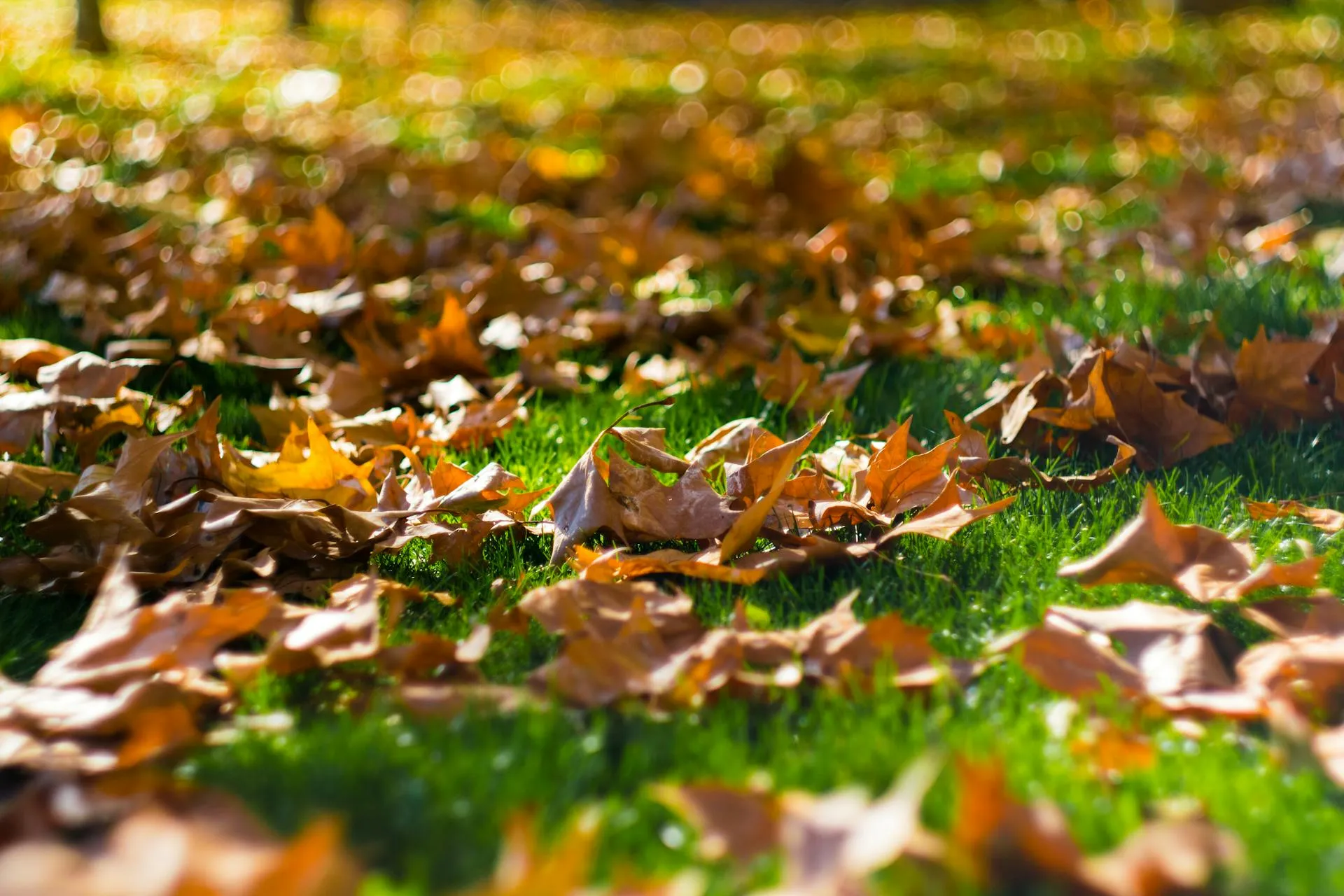
Fall Lawn Care Guide: What to Do & When to Do It
The Right Fall Lawn Treatment Makes a Big Difference Come Spring
Fall may signal the slowing of growth, but it’s also one of the most important seasons for setting up your lawn for spring success. It’s the ideal time for a fall lawn treatment to promote deeper roots, encourage winter nutrient storage, and get a step up on weeds. The timing is crucial! After all, these tasks have to be done in the limited time before the first frost arrives.
Your exact location determines a lot. In general, autumn weather changes start to impact warm-season lawns in the South between August and October. But the different weather, elevation, average rainfall, and grass type in the Austin area all play a part in the precise when and how of your fall lawn care.
Keep reading for fall lawn maintenance tips to keep your Texas yard healthy all the way until spring! Want expert help? Reach out to the professionals at Real Green!
Mowing Tips for Fall in Texas
Mow at a height of approximately 2″ in September and October. However, for the final cut before winter, leave your grass slightly taller, maybe even 3″. This better protects your grass from frost and cold damage as well as disease.

Will your grass grow all winter long? No, warm-season grasses go dormant (and stop growing) once temperatures drop below 50 degrees Fahrenheit. So it’s important to pay attention to the weather for the perfect timing of your final mow before winter.
What to Do With Leaves?
Although a cover of fallen leaves can be beautiful, it is one of the most significant dangers to your lawn in the fall. A thick layer prevents sunlight and moisture from moving through it, creating a wet environment that can invite fungal diseases or even suffocate the grass underneath.
Your best options for dealing with leaves? Raking with a good old-fashioned rake and then removing them, or using the more efficient method of mulch mowing.
If you do choose to mulch the leaves, the most important thing is to do it properly. Always wait until the leaves are dry to mow cleanly, and mow often enough so you are not unloading a thick pile.
Try to shred them into dime-sized pieces that filter down to the soil surface. Eventually, these will decompose and naturally build the soil. It’s like a free source of nutrient-rich material similar to a fall lawn treatment!
Dethatch the Grass
Thatch is fine, but too much isn’t. It regulates the soil’s temperature and helps with moisture retention, kind of like mulch. Soil microbes break down the organic material, returning nutrients to the soil. In short, a thatch can decrease water loss through evaporation, improve soil tolerance to temperature swings, and lessen compaction.
The perfect amount of thatch? About 1/2 inch. Any more than that can end up hurting rather than helping your grass.
So what does lawn dethatching do? It improves water infiltration and nutrient absorption. Plus, it gets your grass ready for new growth!
However, don’t forget that dethatching can stress your grass. That means it should only be done when your lawn is healthy and prepped for a fast recovery. Therefore, the best time to dethatch warm-season lawns is in the late spring. In addition, a light fall dethatching is helpful as well.
Aerate Your Lawn
For warm-season grasses or lawns with compaction problems, liquid aeration is typically suggested. This applies to Bermuda, Zoysia, and St. Augustine lawns.
The best time to aerate? When these grasses are waking up in late spring or early summer (April to June). Another good time? When the soil is cooler and grass is strengthening its root system in early fall (September to October).
How do you know if your grass needs to be aerated? Look for the following signs.
- Water doesn’t easily soak into the grass
- It feels spongy, possibly indicating excess thatch
- Fertilizer doesn’t lead to any improvement
- Your lawn is thin or patchy in spots
- Weeds or moss are taking over due to compaction
- It’s been a year or more since your last lawn aeration
But how often should you aerate your lawn? If it gets heavy use from kids or pets or your region has clay soil, aerate annually. Aerate once per year or even every other year if you have sandy soil or low traffic in your yard.
Here’s when it may make sense for DIY aeration:
- Smaller yards
- You want to spend less but work harder
- You’re comfortable with rental equipment
- You’re strong enough to use heavy equipment
Professional experience is better if:
- You have a larger yard
- There’s extreme compaction or thatch
- You care about your lawn’s overall health
- You want to use your time on something you enjoy instead of sweating!

Watering Schedule for Fall in Austin, TX
In general, for efficient watering, you should either water at night or in the early morning. You can reduce the effects of evaporation by watering after sunset or prior to sunrise.
Remember to also water deeply and infrequently. This promotes deeper roots because it soaks the soil multiple inches down. Lighter daily sprinkles won’t have the same positive impact.
In the fall, you should adjust your watering schedule as grass growth slows down. At the same time, a consistent schedule helps fortify new plants and prep existing ones for colder weather.
When winter arrives, be sure to adjust your watering based on Austin’s weather. Until the first freeze, you can actually continue watering. This helps avoid dry soil and protects the roots from damage.
Not sure when to expect the first freeze in your area? Try entering your zipcode into this frost calculator to get an idea of the dates it typically happens near you.
What to Know About Fall Fertilization
It’s time to help your lawn recover from summer stress, prep for winter, and get set up for a healthy return in spring. When it comes to timing your fall fertilization, aim for a month or two before the first frost. Balanced fertilizers with potassium and nitrogen should be your go-to in autumn.
Potassium strengthens your lawn against drought and disease, giving it the resilience and prolonged health it needs to get through colder months.
As for nitrogen, it can improve your lawn’s density and aid in spring recovery. However, remember that applying it too late can harm warm-season grasses by delaying dormancy, which puts the turf more at risk when the first frost comes.
Weed Control in Fall
Fall is one of the best times to kill broadleaf weeds like dandelions, crabgrass, clover, and more. This is when those kinds of weeds store nutrients in their roots before winter. Spraying them with herbicides in autumn means they’ll absorb the weed killer as well!
Pre-emergent herbicides work by creating a barrier in the soil that stops weed seeds from sprouting. The timing of this strategy is pivotal, as the pesticide must be applied before the temperature rises and weeds start to grow again.
That’s why these are ideal for a fall lawn treatment. Many warm-season turfs go dormant when winter comes (and temps drop). Pre-emergents will keep grasses safer from weeds that may pop up in the months ahead.
Post-emergent herbicides work on weeds that are already visible. They’re scattered directly onto the leaves of weeds that are growing. This kind of weed control may use spot spraying to treat individual weeds. On the flip side, broadcast spraying attacks a whole area where weeds may or may not be present.
Soil Testing & pH Correction
Moderate fall temperatures combined with moisture provide an ideal opportunity for soil amendments to work their magic. Testing is easy. In fact, you can get a DIY kit or send a sample to your local cooperative extension office to get a more in-depth analysis. Your test results will reveal both the pH and nutrient profile of your soil and give you a roadmap to understand what to do next.
If your results show that your soil is too acidic, fall is the best time to apply lime, which slowly moves down through the soil to change the pH over time. If your soil is too alkaline, sulfur can help to improve it.
Final Lawn Care To-Dos Before Winter
Taking care of a few last-minute chores before the winter freeze makes a big difference. It sets you up for a seamless start the following spring. This fall lawn care schedule should serve as your end-of-season checklist:
- Cleaning and storing your lawn tools to prevent rust and damage
- Doing a final mow and possibly bagging the clippings to remove any disease spores
- Mulching the last thin layer of fallen leaves to add organic matter without suffocating the turf
- Setting up your lawn care calendar for spring so you’re prepared to start fertilizing and applying pre-emergent at the proper times
Your hard work today will pay off when your grass begins to green up again in a few months!
FAQs About Fall Lawn Maintenance
What is the best fall fertilizer for my grass type?
A soil test can help determine this. This kind of test will typically suggest the ideal ratio of nitrogen, phosphorus, and potassium needed for your specific warm-season grass. Generally, potassium and nitrogen should be the focus in fall fertilizers since they better prepare your turf for winter weather.
When should I stop watering my lawn?
You can continue watering in the early morning (to prevent disease) in fall, but should stop watering once temperatures are consistently below 40 degrees Fahrenheit.
Should I remove clippings in fall?
If you have a large amount of clippings, you can bag them to remove the threat of disease or grass suffocation. However, smaller clippings are beneficial as they add nutrients back into the soil.
Make Your Autumn Lawn an Awesome Lawn!
Every season has important steps you need to take to achieve the best yard possible. Fall is no different! Follow our fall lawn care tips to keep your grass healthy today and get ready for a beautiful lawn in the year ahead.
Interested in a professional fall lawn treatment service? Reach out to Real Green today! We proudly serve Austin and the surrounding communities of Central Texas, ensuring high-quality lawn care and pest control services across the area.
